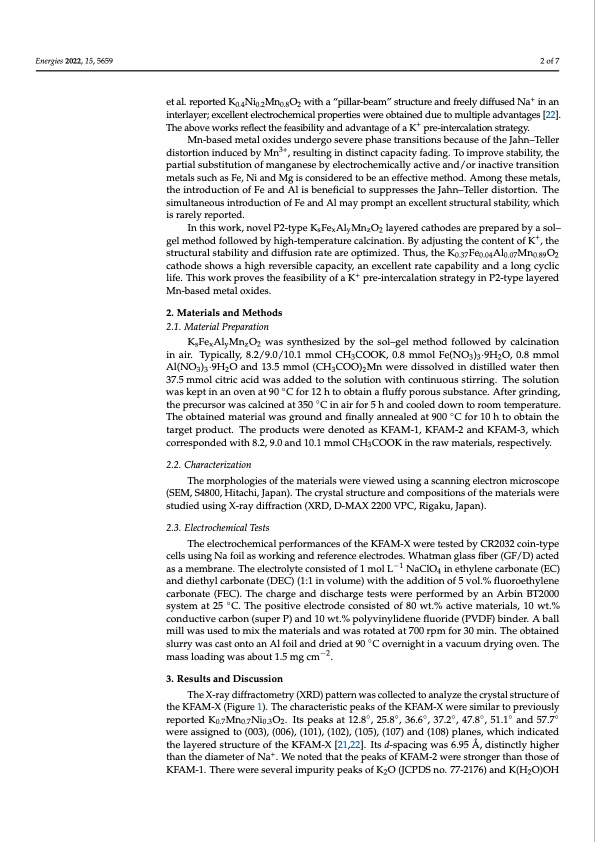
PDF Publication Title:
Text from PDF Page: 002
Energies 2022, 15, 5659 2 of 7 et al. reported K0.4Ni0.2Mn0.8O2 with a “pillar-beam” structure and freely diffused Na+ in an interlayer; excellent electrochemical properties were obtained due to multiple advantages [22]. The above works reflect the feasibility and advantage of a K+ pre-intercalation strategy. Mn-based metal oxides undergo severe phase transitions because of the Jahn–Teller distortion induced by Mn3+, resulting in distinct capacity fading. To improve stability, the partial substitution of manganese by electrochemically active and/or inactive transition metals such as Fe, Ni and Mg is considered to be an effective method. Among these metals, the introduction of Fe and Al is beneficial to suppresses the Jahn–Teller distortion. The simultaneous introduction of Fe and Al may prompt an excellent structural stability, which is rarely reported. In this work, novel P2-type KsFexAlyMnzO2 layered cathodes are prepared by a sol– gel method followed by high-temperature calcination. By adjusting the content of K+, the structural stability and diffusion rate are optimized. Thus, the K0.37Fe0.04Al0.07Mn0.89O2 cathode shows a high reversible capacity, an excellent rate capability and a long cyclic life. This work proves the feasibility of a K+ pre-intercalation strategy in P2-type layered Mn-based metal oxides. 2. Materials and Methods 2.1. Material Preparation KsFexAlyMnzO2 was synthesized by the sol–gel method followed by calcination in air. Typically, 8.2/9.0/10.1 mmol CH3COOK, 0.8 mmol Fe(NO3)3·9H2O, 0.8 mmol Al(NO3)3·9H2O and 13.5 mmol (CH3COO)2Mn were dissolved in distilled water then 37.5 mmol citric acid was added to the solution with continuous stirring. The solution was kept in an oven at 90 ◦C for 12 h to obtain a fluffy porous substance. After grinding, the precursor was calcined at 350 ◦C in air for 5 h and cooled down to room temperature. The obtained material was ground and finally annealed at 900 ◦C for 10 h to obtain the target product. The products were denoted as KFAM-1, KFAM-2 and KFAM-3, which corresponded with 8.2, 9.0 and 10.1 mmol CH3COOK in the raw materials, respectively. 2.2. Characterization The morphologies of the materials were viewed using a scanning electron microscope (SEM, S4800, Hitachi, Japan). The crystal structure and compositions of the materials were studied using X-ray diffraction (XRD, D-MAX 2200 VPC, Rigaku, Japan). 2.3. Electrochemical Tests The electrochemical performances of the KFAM-X were tested by CR2032 coin-type cells using Na foil as working and reference electrodes. Whatman glass fiber (GF/D) acted as a membrane. The electrolyte consisted of 1 mol L−1 NaClO4 in ethylene carbonate (EC) and diethyl carbonate (DEC) (1:1 in volume) with the addition of 5 vol.% fluoroethylene carbonate (FEC). The charge and discharge tests were performed by an Arbin BT2000 system at 25 ◦C. The positive electrode consisted of 80 wt.% active materials, 10 wt.% conductive carbon (super P) and 10 wt.% polyvinylidene fluoride (PVDF) binder. A ball mill was used to mix the materials and was rotated at 700 rpm for 30 min. The obtained slurry was cast onto an Al foil and dried at 90 ◦C overnight in a vacuum drying oven. The mass loading was about 1.5 mg cm−2. 3. Results and Discussion The X-ray diffractometry (XRD) pattern was collected to analyze the crystal structure of the KFAM-X (Figure 1). The characteristic peaks of the KFAM-X were similar to previously reported K0.7Mn0.7Ni0.3O2. Its peaks at 12.8◦, 25.8◦, 36.6◦, 37.2◦, 47.8◦, 51.1◦ and 57.7◦ were assigned to (003), (006), (101), (102), (105), (107) and (108) planes, which indicated the layered structure of the KFAM-X [21,22]. Its d-spacing was 6.95 Å, distinctly higher than the diameter of Na+. We noted that the peaks of KFAM-2 were stronger than those of KFAM-1. There were several impurity peaks of K2O (JCPDS no. 77-2176) and K(H2O)OHPDF Image | Material as a High-Performance Cathode Sodium-Ion Batteries

PDF Search Title:
Material as a High-Performance Cathode Sodium-Ion BatteriesOriginal File Name Searched:
energies-15-05659.pdfDIY PDF Search: Google It | Yahoo | Bing
Salgenx Redox Flow Battery Technology: Salt water flow battery technology with low cost and great energy density that can be used for power storage and thermal storage. Let us de-risk your production using our license. Our aqueous flow battery is less cost than Tesla Megapack and available faster. Redox flow battery. No membrane needed like with Vanadium, or Bromine. Salgenx flow battery
| CONTACT TEL: 608-238-6001 Email: greg@salgenx.com | RSS | AMP |